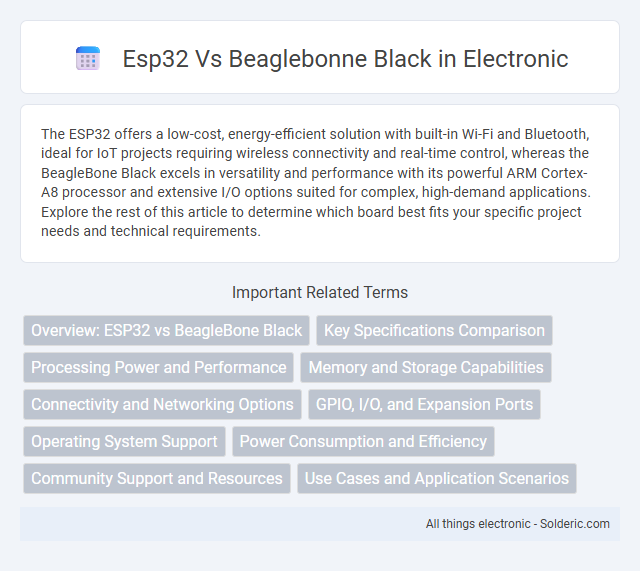The ESP32 offers a low-cost, energy-efficient solution with built-in Wi-Fi and Bluetooth, ideal for IoT projects requiring wireless connectivity and real-time control, whereas the BeagleBone Black excels in versatility and performance with its powerful ARM Cortex-A8 processor and extensive I/O options suited for complex, high-demand applications. Explore the rest of this article to determine which board best fits your specific project needs and technical requirements.
Comparison Table
| Feature | ESP32 | BeagleBone Black |
|---|---|---|
| Processor | Dual-core Tensilica LX6, 240 MHz | AM335x 1GHz ARM Cortex-A8 |
| RAM | 520 KB SRAM | 512 MB DDR3 |
| Storage | Flash: Up to 16 MB (external) | 4 GB 8-bit eMMC on-board |
| Connectivity | Wi-Fi 802.11 b/g/n, Bluetooth 4.2 | Ethernet 10/100 Mbps, USB, No onboard Wi-Fi |
| GPIO Pins | 34 programmable GPIOs | 69 digital I/O pins |
| Operating Voltage | 3.0V to 3.6V | 3.3V |
| Power Consumption | Low power modes; ~80mA active | Higher power, typically >400mA |
| Operating System | No OS or FreeRTOS | Linux (Debian) |
| Use Case | IoT, embedded applications, wearable devices | Linux development, robotics, industrial control |
| Price Range | $4 - $10 | $45 - $60 |
Overview: ESP32 vs BeagleBone Black
The ESP32 is a low-cost, low-power microcontroller with integrated Wi-Fi and Bluetooth, ideal for IoT projects requiring wireless connectivity and energy efficiency. The BeagleBone Black offers a more powerful ARM Cortex-A8 processor, extensive GPIOs, and runs a full Linux operating system, making it suitable for complex embedded applications and development environments. Your choice depends on whether you need lightweight wireless control or robust processing capabilities with Linux support.
Key Specifications Comparison
The ESP32 features a dual-core 240 MHz Xtensa LX6 processor with integrated Wi-Fi and Bluetooth capabilities, making it ideal for IoT projects requiring wireless connectivity. The BeagleBone Black offers a 1 GHz ARM Cortex-A8 processor with extensive I/O options, including HDMI, Ethernet, and multiple GPIO pins, better suited for complex applications demanding higher processing power and expandability. Your choice depends on whether you prioritize low-power wireless communication (ESP32) or more robust processing and peripheral support (BeagleBone Black).
Processing Power and Performance
ESP32 features a dual-core Tensilica LX6 processor running at up to 240 MHz, providing efficient performance for IoT applications and real-time tasks with integrated Wi-Fi and Bluetooth. BeagleBone Black is powered by a 1 GHz ARM Cortex-A8 processor, offering higher processing power suitable for complex computing, Linux-based applications, and advanced embedded systems. The BeagleBone Black outperforms the ESP32 in raw computational ability and multitasking capabilities but consumes more power and lacks built-in wireless connectivity.
Memory and Storage Capabilities
The ESP32 features up to 520 KB of SRAM with external flash storage options typically ranging from 4 MB to 16 MB, suitable for lightweight IoT applications. The BeagleBone Black offers 512 MB of DDR3 RAM and 4 GB of onboard eMMC storage, providing significantly more memory and storage capacity for complex computing tasks. Your choice depends on whether you need the ESP32's energy-efficient embedded systems or the BeagleBone Black's robust memory for advanced projects.
Connectivity and Networking Options
The ESP32 offers robust connectivity with integrated Wi-Fi 802.11 b/g/n and Bluetooth 4.2 dual-mode, making it ideal for IoT applications requiring wireless communication. The BeagleBone Black, while lacking built-in Wi-Fi and Bluetooth, supports Ethernet connectivity and can extend wireless capabilities through USB adapters or expansion capes. Both platforms provide versatile networking options, but ESP32 excels in low-power wireless protocols, whereas BeagleBone Black offers more stable wired network performance.
GPIO, I/O, and Expansion Ports
The ESP32 offers up to 34 programmable GPIO pins supporting multiple functions such as ADC, DAC, PWM, and touch sensors, ideal for flexible I/O operations. The BeagleBone Black features 65 GPIO pins with extensive I/O support, including ADC, PWM, UART, SPI, and I2C, providing robust connectivity options for complex projects. Expansion capabilities include the ESP32's support for external modules via SPI and I2C, while the BeagleBone Black boasts two 46-pin headers allowing rich expansion through cape add-ons and a wider range of peripheral integrations.
Operating System Support
The ESP32 primarily supports lightweight real-time operating systems such as FreeRTOS, making it ideal for IoT applications requiring low power and real-time capabilities. In contrast, the BeagleBone Black runs full Linux distributions like Debian and Ubuntu, providing extensive OS-level functionality for complex computing tasks. This difference highlights the ESP32's suitability for embedded systems, while the BeagleBone Black excels in applications demanding richer OS environments.
Power Consumption and Efficiency
The ESP32 excels in power consumption, offering multiple low-power modes with consumption as low as 10 uA in deep sleep, making it ideal for battery-powered and energy-efficient applications. Conversely, the BeagleBone Black, powered by a 1 GHz ARM Cortex-A8 processor, typically draws significantly more power, around 200-400 mA, suited for higher-performance tasks but less optimal for low-power requirements. Your choice depends on whether energy efficiency or processing power is the priority in your embedded project.
Community Support and Resources
ESP32 benefits from a vast community of developers and extensive resources, including numerous forums, libraries, and tutorials specifically tailored to IoT and embedded applications. BeagleBone Black also has strong community support, particularly in industrial and robotics applications, with abundant documentation, software packages, and active mailing lists. The ESP32's broader adoption in consumer electronics generally results in faster updates and more diverse project examples compared to BeagleBone Black.
Use Cases and Application Scenarios
The ESP32 excels in IoT projects, wearable devices, and low-power wireless communication due to its integrated Wi-Fi and Bluetooth capabilities, making it ideal for smart home automation and remote sensor monitoring. The BeagleBone Black, with its powerful ARM Cortex-A8 processor and extensive I/O options, suits complex embedded systems, industrial automation, and real-time applications requiring high processing power and peripheral connectivity. Both platforms support development in robotics and prototyping, but ESP32 is favored for lightweight, battery-powered devices, while BeagleBone Black handles resource-intensive tasks with broader Linux support.
esp32 vs beaglebonne black Infographic

 solderic.com
solderic.com